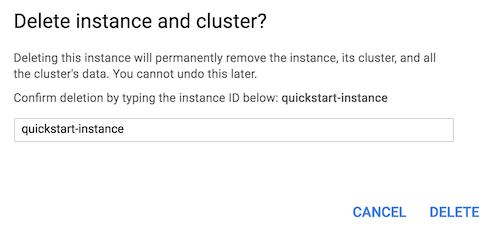 README
¶
README
¶
Cloud Bigtable Hello World
This is a simple application that demonstrates using the go Google Cloud API to connect to and interact with Cloud Bigtable. This project adds automatic exports of tracing to stackdriver and Z-Pages that show information about traces on the local machine.
See the documentation for this sample for a brief explanation of the hello world code.
Table of Contents
- Downloading the sample
- Costs
- Before you begin
- Provisioning an instance
- Running the application
- Cleaning up
Downloading the sample
Download the sample app and navigate into the app directory:
-
Clone the Cloud Bigtable examples repository, to your local machine:
git clone https://github.com/GoogleCloudPlatform/cloud-bigtable-examples.gitAlternatively, you can download the sample as a zip file and extract it.
-
Change to the Hello World code sample directory.
cd cloud-bigtable-examples/node/hello-world
Costs
This sample uses billable components of Cloud Platform, including:
- Google Cloud Bigtable
Use the Pricing Calculator to generate a cost estimate based on your projected usage. New Cloud Platform users might be eligible for a free trial.
Before you begin
This sample assumes you have Go with a minimum version of 1.6.x installed.
Importing Go dependencies
Run the following command to import the bigtable library dependency:
go get -u
Creating a Project in the Google Cloud Platform Console
If you haven't already created a project, create one now. Projects enable you to manage all Google Cloud Platform resources for your app, including deployment, access control, billing, and services.
- Open the Cloud Platform Console.
- In the drop-down menu at the top, select Create a project.
- Give your project a name.
- Make a note of the project ID, which might be different from the project name. The project ID is used in commands and in configurations.
Enabling billing for your project.
If you haven't already enabled billing for your project, enable billing now. Enabling billing allows is required to use Cloud Bigtable and to create VM instances.
Enable the Cloud Bigtable APIs.
Make sure to enable the Bigtable APIs.
Install the Google Cloud SDK.
If you haven't already installed the Google Cloud SDK, install the Google Cloud SDK now. The SDK contains tools and libraries that enable you to create and manage resources on Google Cloud Platform.
Setting Google Application Default Credentials
Set your Google Application Default Credentials by initializing the Google Cloud SDK with the command:
gcloud init
Generate a credentials file by running the application-default login command:
gcloud auth application-default login
Provisioning an instance
Follow the instructions in the user documentation to create a Google Cloud Platform project and Cloud Bigtable instance if necessary. You'll need to reference your project id and instance id to run the application.
Running the application
Run the sample using node. Replace BIGTABLEINSTANCE with what you called
it when provisioning the instance.
INSTANCE_ID=BIGTABLEINSTANCE node index.js
You will see output resembling the following, interspersed with informational logging from the underlying libraries:
Creating table Hello-Bigtable
Write some greetings to the table
Reading a single row by row key
Read: Hello World!
Reading the entire table
Read: Hello World!
Read: Hello Bigtable!
Read: Hello Node!
Delete the table
Cleaning up
To avoid incurring extra charges to your Google Cloud Platform account, remove the resources created for this sample.
-
Go to the Cloud Bigtable instance page in the Cloud Console.
-
Click on the instance name.
-
Click Delete instance.

-
Type the instance ID, then click Delete to delete the instance.
 Documentation
¶
Documentation
¶
There is no documentation for this package.